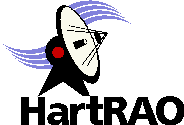Left click on image for large version. Credit: Denise Dale / HartRAO
Astronomer Marion West introduced the trainees to HartRAO and
the astronomy research carried out here.

HartRAO Home > news > Ghanaian Radio Astronomy Training at HartRAO - 2013-10-14
A team from the Ghana Space Science and Technology Institute arrived in
South Africa on 2013 October 14 to begin training towards the conversion and
operation of the
Kuntunse satellite antenna near Accra as a radio telescope.
The group comprised Emmanuel Adzri (science processing), Theophilus Ansahnarh (software), Joyce Korantengacquah (Project Manager), Severin Azakpo (structural and mechanical), Felix Madjitey (structural and mechanical), Emmanuel Mornoh (control and monitoring), Joseph Nsor (signal chain / Radio Frequency).
The first week of their visit was spent having orientation training at HartRAO.
The photos below give the flavour of how the time was spent at HartRAO.
Left click on image for large version. Credit: Denise Dale / HartRAO
Astronomer Marion West introduced the trainees to HartRAO and
the astronomy research carried out here.
Left click on image for large version. Credit: Denise Dale / HartRAO
Anita Loots, the Project Leader for the African VLBI Network within the
South African SKA Project, provided orientation on the AVN.
Left click on image for large version. Credit: Denise Dale / HartRAO
A tour of the observatory started at the 15m radio telescope which was built in 2007 as the first
prototype for the Karoo Array Telescope (now MeerKAT), and later converted
for operational use for Very Long Baseline Interferometry (VLBI) by HartRAO.
Left click on image for large version. Credit: Denise Dale / HartRAO
The C-Band All Sky Survey (C-BASS) Southern test telescope is in development at
HartRAO by an international research team.
Left click on image for large version. Credit: Denise Dale / HartRAO
Group photo with Anita Loots and Marion West.
Left click on image for large version. Credit: Denise Dale / HartRAO
Head of Space Geodesy Ludwig Combrinck at right describing the radio telescope control room to the
group.
Left click on image for large version. Credit: Denise Dale / HartRAO
The group visited the NASA Satellite Laser Ranger operated by HartRAO.
Left click on image for large version. Credit: Denise Dale / HartRAO
Inside the Satellite Laser Ranger control room.
Left click on image for large version. Credit: Denise Dale / HartRAO
The next day the group were able to climb the 26m radio telescope to see its
systems close up.
Left click on image for large version. Credit: Denise Dale / HartRAO
Ascending the North ladder of the 26m telescope.
Left click on image for large version. Credit: Denise Dale / HartRAO
Antenna specialist Pieter Stronkhorst, in the yellow shirt, shows the group
where to walk as they arrive in main reflector surface of the telescope.
Left click on image for large version. Credit: Denise Dale / HartRAO
The group climbed inside the Cassegrain cone to see the multiple radio
receivers and cryogenic refrigerators used to cool the receivers to -257
Celcius in order to improve their sensitivity.
Left click on image for large version. Credit: Denise Dale / HartRAO
Leaving the Cassegrain cone.
Left click on image for large version. Credit: Denise Dale / HartRAO
Pieter Stronkhorst points out the subreflector with its computer-controlled tilt and focus
mechanisms.
Left click on image for large version. Credit: Denise Dale / HartRAO
Descending the North ladder - carefully!
Left click on image for large version. Credit: Denise Dale / HartRAO
Retired HartRAO Director George Nicolson, who remains actively involved in
research, was able to visit and share his experience with the group.
Left click on image for large version. Credit: Denise Dale / HartRAO
George Nicolson with the Ghanaian group.
Left click on image for large version. Credit: Denise Dale / HartRAO
Back in the classroom, Sarah Buchner introduced basic theory of how radio
telescopes work.
Left click on image for large version. Credit: Denise Dale / HartRAO
Using a domestic satellite receiver with a radiometer attached, the group
measure the strength of the radio emission from the Sun.
Left click on image for large version. Credit: Denise Dale / HartRAO
The group paying close attention to the radiometer in order to measure the
peak strength of the solar radio emission.
Left click on image for large version. Credit: Denise Dale / HartRAO
The group having a relaxing lunch outdoors at HartRAO.
Left click on image for large version. Credit: Denise Dale / HartRAO
Back in the classroom, astronomer Alet de Witt explains the astronomical
coordinate systems they will encounter.
Left click on image for large version. Credit: Denise Dale / HartRAO
The starglobe provides a 3D visualization of the astronomical coordinate
systems.
Left click on image for large version. Credit: Denise Dale / HartRAO
Astronomer Michael Bietenholz described some the science done with radio
telescopes operating as a Very Long Baseline Interferometry (VLBI) array.
Left click on image for large version. Credit: Tony Dhlamini / HartRAO
A last group photo with the HartRAO 26m and 15m telescopes in the
background.